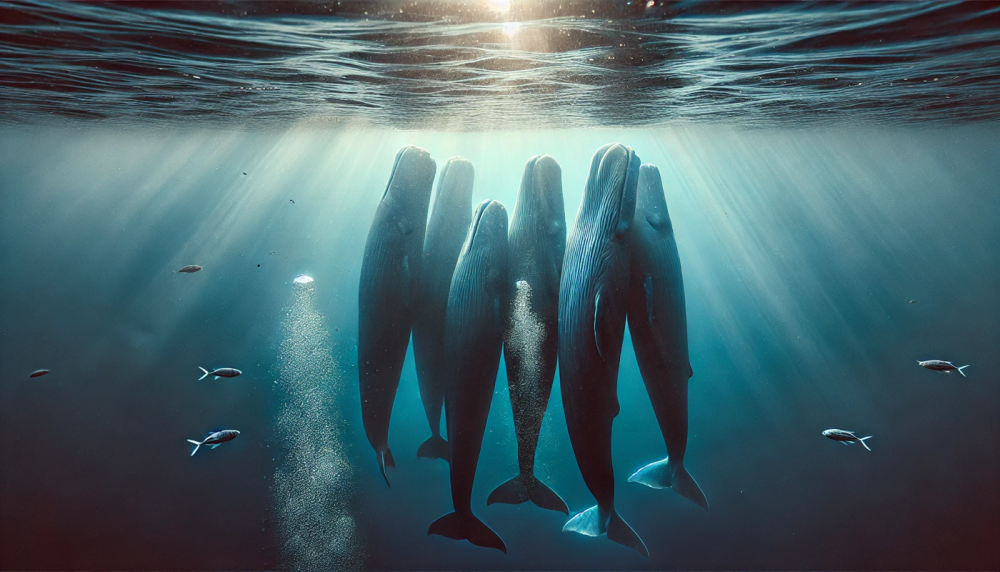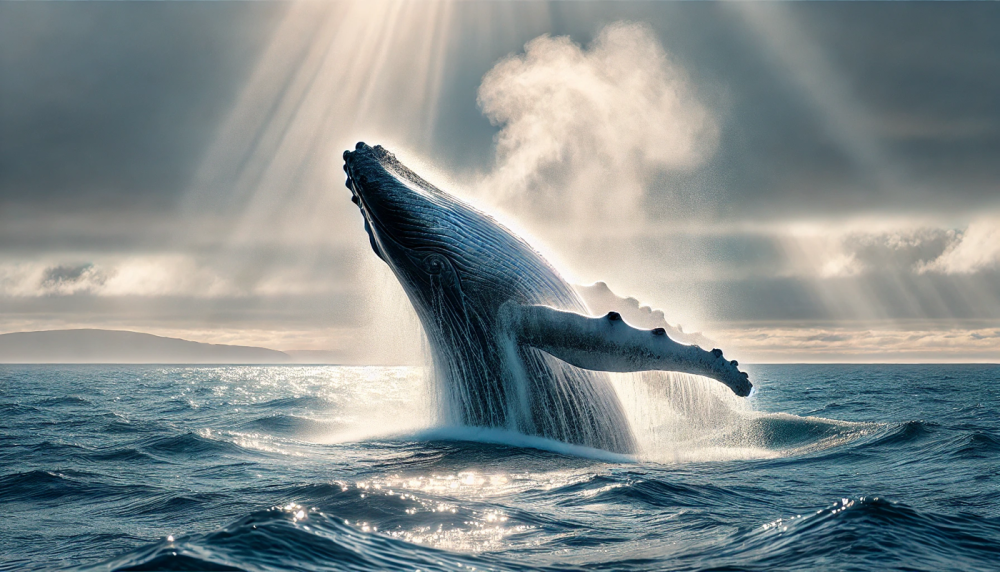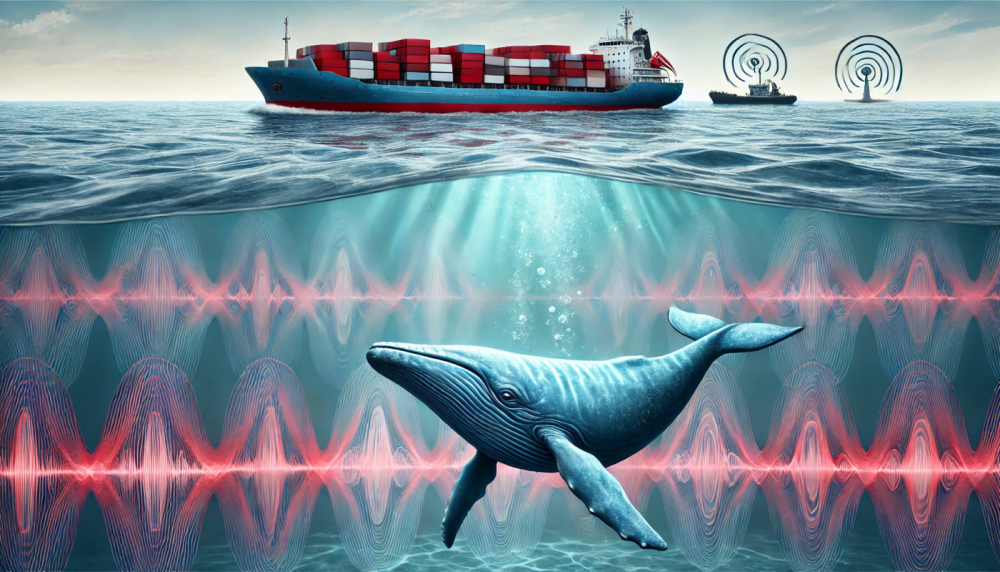The Ocean’s Giants and Their Lifeline
The ocean is an untamed world, vast and unyielding. Its surface roils
and churns under the force of wind and tide. Yet in the midst of it all,
whales rise—massive, deliberate, and unshaken. Their world is one of deep
silence and endless blue, but air is their lifeline. No matter the
conditions, whether beneath tranquil waters or amidst the fury of a storm,
they must return to the surface.
Conscious Breathing and Sleep
Unlike us, whales do not breathe by reflex. Each breath is a conscious
decision, an action they must take with full awareness.[¹] While we drift
into sleep and let our lungs work without thought, a whale remains ever
mindful of its next breath. Because of this, they never fully sleep as we
do. Instead, one half of their brain rests while the other stays alert,
ensuring they return to the surface at the right moment.[²] Recent studies
have also observed sperm whales in a vertical resting position near the
surface, suggesting variations in sleep behaviors across species.[³]
Navigating the Depths
But how do they know when that time has come? As they near the surface,
their bodies prepare for the critical moment of respiration, ensuring
efficiency and precision in every breath. The ocean offers no markers, no
visual cues to guide them upward. Yet they ascend with precision, never
surfacing too soon or too late. Their awareness of their surroundings
does not depend on sight but on the water itself. As they climb, the
pressure that once pressed against their massive bodies begins to ease,
signaling that the surface is near. Their finely tuned inner ears detect
these subtle changes, helping them regulate their ascent.[⁴] Additionally,
whales possess adaptations to avoid decompression sickness—unlike humans,
they can collapse their lungs at depth, preventing nitrogen absorption
that would otherwise cause dangerous bubbles in their bloodstream.[⁵]
The Role of Sound and Pressure Awareness
For some, like the toothed whales—dolphins, orcas, and sperm whales—sound
plays a role as well. Their ability to echolocate allows them to sense the
surface before reaching it, sending out sound waves that bounce back with
information about what lies ahead.[⁶] Unlike toothed whales, baleen whales
lack echolocation but may still use low-frequency sounds and environmental
cues to navigate. Some studies suggest they use vocalizations and water
pressure changes to guide their ascent.[⁷]
The Act of Breathing
As they draw closer, their bodies are already preparing for what comes
next. The muscles around the blowhole engage, primed and ready. The instant
their blowhole meets air, they do not hesitate. A thunderous burst of air
and mist explodes skyward, momentarily scattering the golden sunlight
before vanishing into the wind. This is the spout we see, a fleeting
signature against the sky.[⁸]
In the same moment, the inhalation follows—quick and efficient, filling
their lungs with fresh oxygen in less than a second.[⁹] Then, just as
swiftly, their blowhole seals shut, locking out the ocean’s reach as they
return to the depths. There is no delay, no margin for error. It is a
flawless, practiced motion, honed by design. The structure of their nasal
passages, supported by strong muscular control, ensures that not a single
drop of water enters the respiratory system.[¹⁰]
Adapting to Ocean Turbulence
Yet the sea is not always calm. Waves rise, storms howl, and the surface
becomes a battlefield of wind and water. But even in chaos, the whale
prevails. Their breath does not wait for stillness. A crashing wave at the
wrong moment could spell disaster, yet their bodies anticipate the motion
of the sea. Their exhalation alone is powerful enough to clear away water
before they inhale, and their blowhole, a perfectly controlled gateway,
snaps shut with precise timing, ensuring not a single drop enters where
it does not belong.[¹¹]
However, the modern ocean poses new challenges beyond storms and waves.
Human activity—such as increased ship traffic, sonar use, and noise
pollution—disrupts the natural rhythms of whales. Studies have shown that
high-intensity underwater noise can interfere with echolocation, delay
surfacing, and disrupt normal breathing patterns.[¹²] Conservation efforts
are underway to mitigate these impacts, recognizing the delicate balance
whales maintain between breath and survival.
A Testament to Balance and Design
For a creature so massive, so seemingly invincible, the simple act of
breathing is both an effort and a marvel. And yet, in the rhythm of their
rising and falling, their inhaling and exhaling, there is something almost
poetic. Each breath is a choice. Each return to the surface is a reminder
of the delicate balance they maintain. A balance written into their very
being—by the One who gave them breath in the first place.
The breathtaking design of the whale’s respiratory system is a testament
to Jehovah’s wisdom and power, reflecting His intricate and purposeful
creation. The whale’s ability to balance conscious breathing with
automatic reflexes showcases a level of complexity that only a supreme
Creator could design, mirroring the divine care seen throughout the world.
Just as He has given these magnificent creatures the ability to thrive in
the depths of the ocean, He also provides humans with the wisdom and care
needed for life.
The Bible reminds us in Job 12:7-10: “But ask the animals, and they will
teach you, or the birds in the sky, and they will tell you; or speak to
the earth, and it will teach you, or let the fish in the sea inform you.”
This highlights how creation itself testifies to Jehovah’s wisdom. Just
as whales demonstrate intricate design through their conscious breathing
and reflexive control, they serve as a powerful reminder of the Creator’s
handiwork in sustaining life in the ocean depths.
Sources
1. Baleines en direct. Whale Respiratory Physiology. Published: 2020.
2. Victoria Whale Watching. How Do Whales Sleep? Published: 2021.
3. Miller, P. J. O. et al. Sperm whale resting behavior in the wild.
Marine Mammal Science, 2008.
4. Smithsonian Ocean. How Whales Sense Their Environment. Published: 2019.
5. Fahlman, A. et al. Lung function and gas exchange in deep-diving
marine mammals. The Journal of Experimental Biology, 2017.
6. Whale and Dolphin Conservation. Echolocation in Toothed Whales.
Published: 2022.
7. Goldbogen, J. et al. Low-frequency sound production and communication
in baleen whales. Proceedings of the Royal Society B, 2015.
8. National Geographic. How Whales Breathe. Published: 2020.
9. Journal of Experimental Biology. Whale Blowhole Function. Published: 2019.
10. Baleines en direct. Water Entry Prevention in Whale Nostrils.
Published: 2021.
11. NOAA Fisheries. Whale breath mechanics and ocean turbulence.
Published: 2022.
12. Erbe, C. et al. Effects of underwater noise on marine mammals.
Journal of the Acoustical Society of America, 2019.
Edited by dljbsp
- Roxessence, Myew, hatcheckgirl and 3 others
-
 1
1
-
 2
2
-
 1
1
-
 2
2


2 Comments
Recommended Comments
Join the conversation with your brothers and sisters!
You are posting as a guest. If you are already a member, sign in now to post with your existing account.
Note: Your post will require moderator approval before it will be visible.